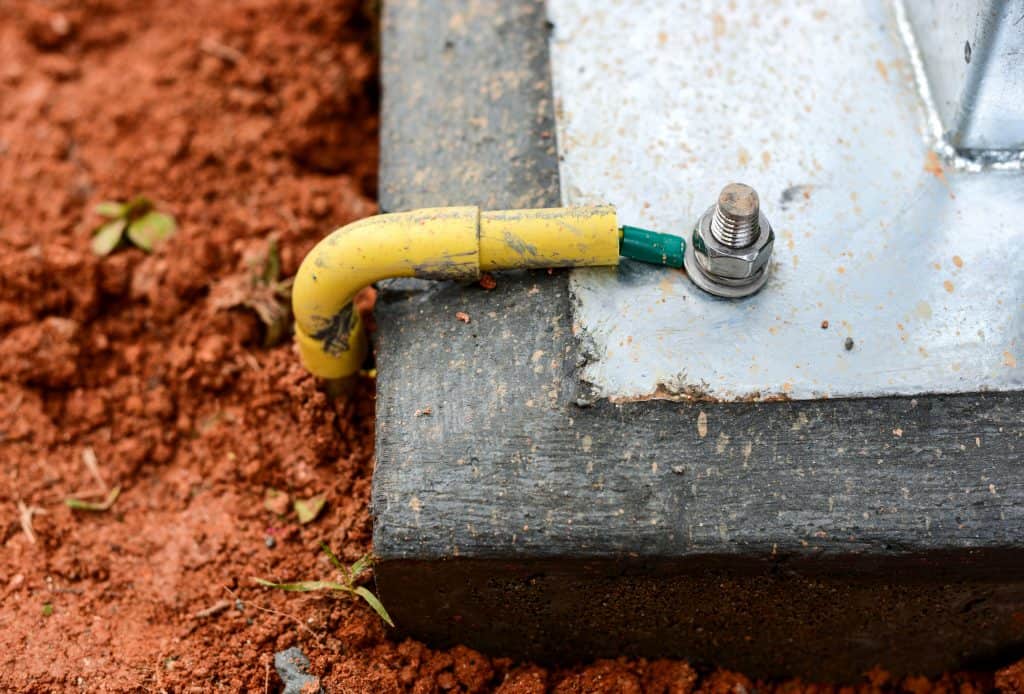Being a grounded person is necessary for a happy life. Having a grounded house is necessary for a happy Building Inspector! And without so many words, your house will thank you too. You may have come across copper grounding rods that look elegant buried in the ground beside a house and then come across other grounding rods which are less elegant rebar buried in foundation concrete. This may leave you asking the question, “Can rebar be used as a grounding rod?”
Rebar used as a grounding rod is subject to corrosion so requires specialized encasing and enough contact with the ground to be effective. Section 250.68(C) of the NEC says rebar may extend from the concrete foundation of a building in an accessible location that is not subject to corrosion.
Grounding an electrical system, especially in a house, is a safety precaution for lightning strikes and other electrical surges, luckily there is an easy and safe way to do it: use trusty rebar that is already being put into the concrete. Brush up on your knowledge of rebar and grounding to give you peace of mind, make your Building Inspector happy and put a smile on your house.
What Is Rebar?
Rebar is a steel bar that is mostly used in concrete construction but also has other applications. Rebar is usually round, but they can be other shapes too and come in different thicknesses.

The name may be a shortened version of ‘reinforcing bar’, but the jury is still out on that. Rebar is mainly used to reinforce concrete by placing it in a concrete slab, giving it structural strength.
There are different types of rebar:
- Carbon steel rebar (low cost and high strength);
- Galvanized rebars (coated with zinc to slow down corrosion);
- Stainless steel rebar (more expensive but doesn’t corrode); and
- Epoxy coated rebar (more economical option for corrosive environments).
Rebar is found in every building you can imagine.
When considering rebar as a grounding rod, keep in mind two things: First, that rebar isn’t usually used as a current conductor but in this case, it is useful for it so builders and electricians do so quite often.
Some might say that a buried copper pipe connected to the electrical system is better, but the National Electrical Code (NEC) allows for rebar to be used so it often is! Secondly, remember that rebar can rust so it will need regular checking, where other electrical equipment is made of materials that are designed to last over extended years.
What Is Grounding?
During an electrical fault or lightning strike, excess electric current in a system may need to be ‘let out’ of the system. The ground underneath a building will naturally accept and dissipate the current, but first, it needs to find its way there that won’t blow up everything in its path.
Placing a metal rod deep enough in the ground that connects one of these rods on the one side and to the electrical system on the other side will give this excess current a pathway to travel. Hence it is called ‘grounding’ because it is routing all excess electricity in the system to the ground.

In conversation, you may hear of grounding to mean the grounding of equipment as well as system grounding. Equipment grounding is connecting the earth ground to non-current carrying conductive materials. System grounding, on the other hand, means the connection of earth ground to the neutral points of current-carrying conductors.
Grounding isn’t necessary for the actual electrical system itself to function, but this intentional addition of metal components that don’t normally carry current to form an electrically conductive path to the earth is what creates safety in the system by reducing the chances that a short circuit will cause a fire or life-threatening shock. Think of it as the escape route for any excess electric current before it can do any major damage.
Does Rebar Need To Be Grounded?
Rebar on its own doesn’t usually need to be grounded. If, however, the rebar is being used in a concrete slab you will need to ground the whole slab. This is because during a fault or lightning strike the ground and the concrete slab will be at a different potential and there may be a touch potential hazard.
The steel reinforcement bars and meshes embedded in the concrete slabs are of high electrical conductivity because they are made up of a large metal cross-sectional area. The closeness of the two electrical conduits may cause arcing between them and damage the concrete or cause other damage.
This grounding of rebar does have an advantage as it comes in useful as a grounding option. If rebar is already buried in concrete and a piece of it can be used as a grounding rod, this will be useful.
The National Electric Code Guidelines For Grounding
Section 250.68(C)(3) of the 2017 National Electrical Code (NEC) reads as follows:
“A rebar type concrete-encased electrode installed in accordance with 250.52(A)(3) with an additional rebar section extended from its location within the concrete to an accessible location that is not subject to corrosion shall be permitted for connection of grounding electrode conductors and bonding jumpers. The rebar extension shall not be exposed to contact with the earth without corrosion protection.”
Section 250.68(C)(3) of the 2017 National Electrical Code (NEC) reads as follows:
For the full listing on the National Electric Code, visit nfpa.org
The National Electrical Code indicates that a ground system should have a grounding resistance of 25 ohms or less. This may mean the need to use more than one ground rod in the installation, these additional grounding rods should be placed at least six feet apart.
Builders and electricians will often leave a specifically placed piece of upturned rebar coming from the foundation to serve as the ground rod. When this rebar-type concrete-encased electrode is installed, it is usually turned up to protrude above the slab with a 90° bend into the wall cavity.
This is where a wire-type grounding electrode conductor (GEC) is connected and runs into the service panel. Commonly, the rebar electrode rises within the stem wall with full concrete encasement until it comes out from the treated wood sill plate.
The most common concern with this method is that the exposed metal of the rebar may corrode over time, especially in wetter or more humid climates. If the corrosion is bad enough this may lead to a complete breakdown of the connection.
Because the rebar is only needed to conduct electricity in an emergency there isn’t usually any indication that there is a problem until it is too late, making corrosion a hazardous problem. The obvious solution to this is regular checking that the rebar is still in good condition.
The place on the rebar where rusting is likely to happen is at the point where the GEC attaches to the reinforcing bar with a ground clamp. If the rebar is placed outside the building this will be even more of a concern and will need more regular checking.
Can A Ground Fault Happen With Rebar?

Ground faults are any unwanted connections between the system conductors and the ground. Ground faults often go unnoticed and can cause havoc with an electrical system. In the worst cases, power will be lost because the electricity is taking the path of least resistance and heading to the ground, bypassing the electrical system altogether.
But this is an uncommon problem. Ground faults with rebar are rare: if everything, including the grounding rods, is installed correctly there shouldn’t be a problem. If there is a problem an electrician should be able to diagnose and fix the problem easily, but be cautious, because these grounding wires are often not sheathed in any protective layer it is best to let a professional look into the problem.
Conclusion
The National Electrical Code indicates that a ground system must be in place on a residential property. During an electrical fault or lightning strike, excess electric current in a system may need to be ‘let out’ of the system. Although copper grounding rods are often seen as the best route to take when installing grounding rods, rebar can also be used safely for this. Rebar is subject to corrosion and so there are installation requirements to stop the corrosion.
